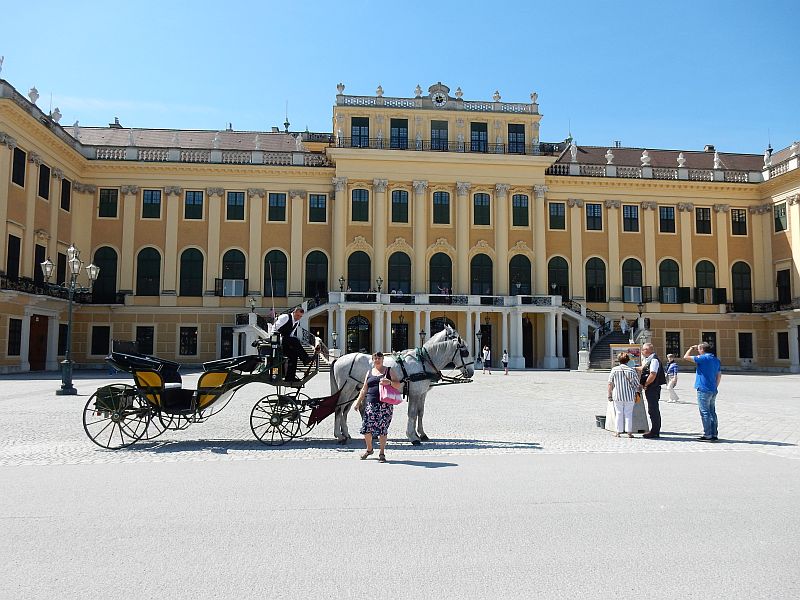
We had left the River Main far behind us and were now at Vienna, on the River Danube. Our first visit was to the magnificent Schonbrunn Palace. The interior of the Palace was stunningly beautiful (we couldn't take photo inside, of course) and it was well worth being on a guided tour. The paintings, furniture, and architecture were all breathtaking, and the gardens (which, we were proudly informed, were bigger than the entire Principality of Monaco) were absolutely incredible.
Amongst many other things I also learned a little more about the history of the Austro-Hungarian Empire; I had known that it was big but had never really appreciated just how huge it was, and now I could understand a little more why the assassination of Archduke Franz-Ferdinand at Sarajevo in 1914 was such a significant act that it precipitated the first World War.
In the evening, while some of the guests were at the Opera, we stayed on board and attempted to drink the ship's bar dry in the company of our two resident guides; we failed in this enterprise, but certainly gave it a good try!
Leaving Vienna we also left Austria and continued down the Danube towards different countries, many of which were not mentioned in our school geography lessons and whose languages (and sometimes even their alphabets) were totally alien to us. The first of these was Slovakia whose capital Bratislava is was small colourful and very pretty (just like our tour guide was); the town centre was full of life, with bright colours and humorous items everywhere.
Walking around the busy streets of Bratislava we passed dozens of people who all seemed to be having a great time in the sunshine; we bought some locally made souvenirs, and after enjoying a couple of ice creams in the sunshine we rejoined the rest of our walking group for a very fine performance by a string quartet in a nearby church.
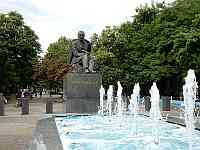 |
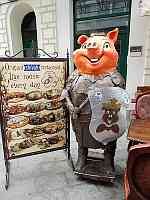 |
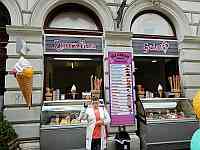 |
Town-centre park in Bratislava |
A jolly pig advertises a restaurant in Bratislava |
We managed to buy ice creams even though we couldn't pronounce "ZMRZLINA" |
We continued down the Danube into the night, and arrived in the Hungarian capital city of Budapest which is essentially two cities of Buda and Pest. We were told that the best way to remember their relationship is that Pest has the Parliament buildings (two P's together) so the other side of the river must be the hillside area of Buda. We were moored outside the iconic Parliament building, which is spectacularly floodlit at night.
Our coach tour of the city the next morning was very interesting, and left us free to explore on our own in the afternoon. We hurried back to Buda and after a stiff walk up the hill (the Funicular railway was closed for repairs) we found the Hospital in the Rock which our friends had said we must see. Built into one of the many natural caves in the hillside below the castle, it is now preserved as an excellent museum. Our visit was fascinating and highly thought-provoking; it has served as an air raid shelter, as a major wartime hospital, a refuge for Jews, a nuclear fall-out shelter, and a medical research establishment. I left with a much better picture of Budapest's bloody and violent history during the 20th century including its particularly bloody periods of 1945 and 1956..
Leaving Budapest we stayed in Hungary and stopped the next morning near the remote town of Kalocza. This area is the centre of Hungary's Paprika industry, and our first visit was to the local Paprika Museum, followed by a visit to a small folk museum, where we watched displays of traditional country dancing and also of incredibly detailed embroidery. Finally in this area we went to a local riding school for an utterly amazing display of horsemanship. If you have time, take a look at the videos which I have placed below the photos here:
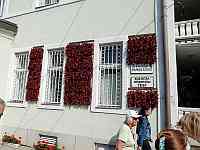 |
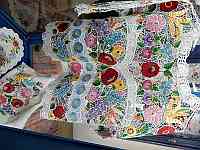 |
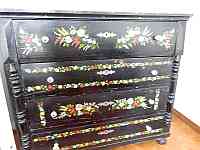 |
Paprika drying on the walls of a Paprika Farm |
A beautiful example of traditional Hungarian embroidery |
This traditional Hungarian chest reminded me of the canal-art roses that we are so familiar with |
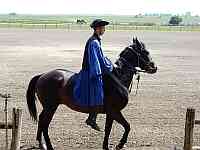 |
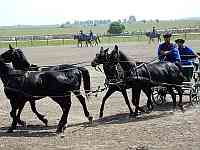 |
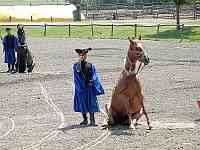 |
One of the horsemen at Kalocza, Hungary |
Carriage driving |
This horse has been trained to act like a dog: it knows sit, down, and stay |
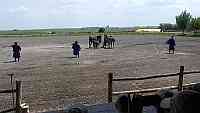 |
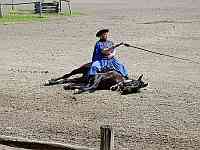 |
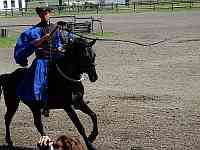 |
A display of synchronised whip-crackingPLAY VIDEO
|
The horse is trained to lie still while the whip cracks above itPLAY VIDEO
|
Cracking a whip to knock bottles over as he gallops past usPLAY VIDEO
|
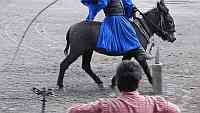 |
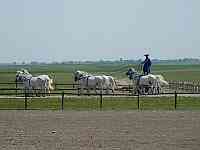 |
 |
How NOT to do itPLAY VIDEO
|
Bareback riding 10 horses at oncePLAY VIDEO |
|
The next country on our itinerary was Serbia which is not yet a member of the European Union so there had to be a border check. In fact we also sailed through a small part of Croatia as the centre of the Danube forms the national boundary, but we did not land in that country. Two customs officers came on board and all the passengers had to parade in front of them; the ship held everybody's passports so the whole exercise was conducted very quickly and efficiently, but in essence it was all just a show. It effectively just confirmed that there was one passport for every passenger who was in the parade; presumably they had checked that none of the passports related to anyone who was of particular interest to them but there was no attempt to match individual passports to particular people.
We hurried down the river to Belgrade, the capital of Serbia, racing to beat the cruise-ship behind us to the best mooring. We were told that Belgrade has been the capital for hundreds of years, they just keep changing which country it is the capital of! With its strategic location at the confluence of two major rivers, and its battle-scarred hilltop fortress, it as always been at a crossroads of many different cultures including Austrian, Turkish, Roman, Ottoman, Byzantine, Romanian, Bulgarian and Russian.. The display of folk-dancing that we watched certainly seemed to reflect this cultural diversity; it even included one that was a weird cross between a Cossack dance and an Argentinean Tango, and indeed the feel of the city itself struck me as being like a cross between Moscow and Buenos Aires if you can imagine such a thing! It was also by far the most miserable city that we visited on our voyage; nobody was smiling and it was hours before I saw the first person who looked even moderately happy. Our tour guide explained to us that they were allowing the whole city to fall into such a state of disrepair that when they joined the EU they would immediately receive billions of Euros to enable them to rebuild everything. Perhaps she was particularly bitter because her family had owned 13 houses in Belgrade but they had all been confiscated by Marshall Tito during his dictatorship, but her comments did seem to make sense as we toured the city. She described to us how President Slobodan Milosevic had demonstrated staggering new depths of political corruption; when he was overthrown they had found several million ballot papers, already completed with votes for his party, ready an election that hadn't even yet been held!
After a rather sombre visit to Tito's mausoleum we were more than ready to leave Belgrade and continue our journey down to the lower Danube
All pictures on this site are © Allan Jones unless otherwise stated